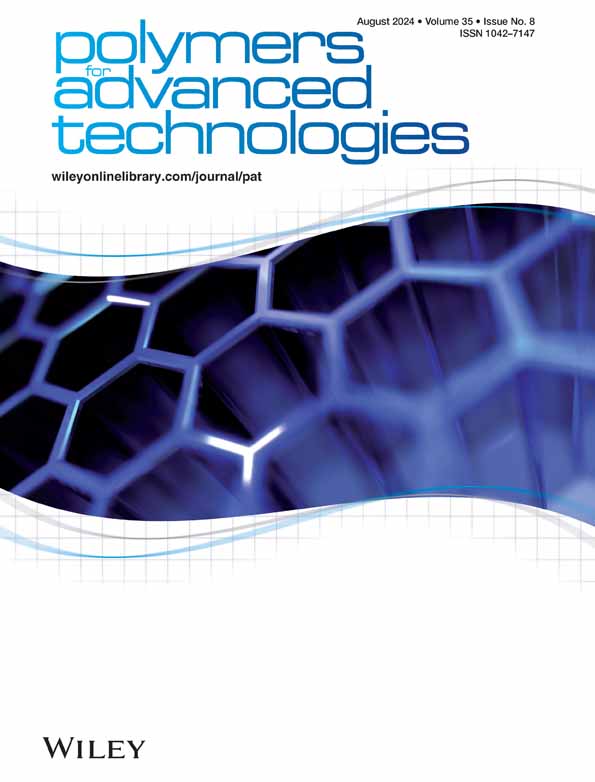Sound absorption properties and mechanism of multi‐layer micro‐perforated nanofiber membrane
IF 3.4
4区 工程技术
Q2 POLYMER SCIENCE
引用次数: 0
Abstract
Aiming at achieving low‐frequency and broadband sound absorption under the premise of light and thin layers, in this paper, polyvinyl butyral (PVB) nanofiber membranes were micro‐perforated and then combined sequentially to prepare multi‐layer micro‐perforated nanofiber membrane (MPNM) for acoustic noise reduction. It was demonstrated that the multi‐layer MPNM exhibited a high absorption (constantly over 50%) in the frequency of 480–2500 Hz. In addition, the established theoretical model of the sound absorbing coefficient can accurately predict the sound absorption performance of the structure with different layers, which can provide a theoretical foundation for the design of the structure of the nanofibrous membrane acoustic absorber. Based on the proposed acoustic model, the relationships between the absorption properties and the parameters were investigated, and it was found that the effective acoustic absorption frequency range and acoustic absorption coefficient curve of the multi‐layer MPNM were closely related to the size and arrangement of hole diameter, perforation rate, fiber membrane thickness, and cavity depth. Optimization of the structural parameters utilizing algorithms can achieve superior sound absorption performance, with an average absorption coefficient of 0.81 in the frequency of 100–2500 Hz. This study provides a theoretical and experimental basis for the development of low‐frequency sound‐absorbing materials and is of great significance for optimizing the acoustic performance of nanofiber membranes and expanding their applications in various acoustic engineering applications.多层微穿孔纳米纤维膜的吸音特性和机理
为了在轻层和薄层的前提下实现低频和宽带吸声,本文对聚乙烯醇缩丁醛(PVB)纳米纤维膜进行了微穿孔,然后依次组合,制备出用于声学降噪的多层微穿孔纳米纤维膜(MPNM)。结果表明,多层 MPNM 在 480-2500 Hz 频率范围内具有很高的吸声率(持续超过 50%)。此外,建立的吸声系数理论模型可以准确预测不同层结构的吸声性能,为纳米纤维膜吸声体的结构设计提供了理论依据。根据提出的声学模型,研究了吸声性能与参数之间的关系,发现多层纳米纤维膜吸声体的有效吸声频率范围和吸声系数曲线与孔径大小和排列方式、穿孔率、纤维膜厚度和空腔深度密切相关。利用算法优化结构参数可获得优异的吸声性能,在 100-2500 Hz 频率范围内的平均吸声系数为 0.81。该研究为低频吸声材料的开发提供了理论和实验依据,对优化纳米纤维膜的吸声性能、拓展其在各种声学工程中的应用具有重要意义。
本文章由计算机程序翻译,如有差异,请以英文原文为准。
求助全文
约1分钟内获得全文
求助全文
来源期刊

Polymers for Advanced Technologies
工程技术-高分子科学
CiteScore
6.20
自引率
5.90%
发文量
337
审稿时长
2.1 months
期刊介绍:
Polymers for Advanced Technologies is published in response to recent significant changes in the patterns of materials research and development. Worldwide attention has been focused on the critical importance of materials in the creation of new devices and systems. It is now recognized that materials are often the limiting factor in bringing a new technical concept to fruition and that polymers are often the materials of choice in these demanding applications. A significant portion of the polymer research ongoing in the world is directly or indirectly related to the solution of complex, interdisciplinary problems whose successful resolution is necessary for achievement of broad system objectives.
Polymers for Advanced Technologies is focused to the interest of scientists and engineers from academia and industry who are participating in these new areas of polymer research and development. It is the intent of this journal to impact the polymer related advanced technologies to meet the challenge of the twenty-first century.
Polymers for Advanced Technologies aims at encouraging innovation, invention, imagination and creativity by providing a broad interdisciplinary platform for the presentation of new research and development concepts, theories and results which reflect the changing image and pace of modern polymer science and technology.
Polymers for Advanced Technologies aims at becoming the central organ of the new multi-disciplinary polymer oriented materials science of the highest scientific standards. It will publish original research papers on finished studies; communications limited to five typewritten pages plus three illustrations, containing experimental details; review articles of up to 40 pages; letters to the editor and book reviews. Review articles will normally be published by invitation. The Editor-in-Chief welcomes suggestions for reviews.
 求助内容:
求助内容: 应助结果提醒方式:
应助结果提醒方式:


